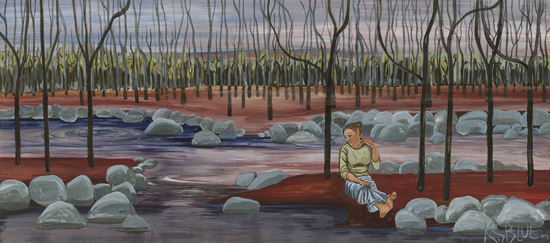Burial Rights: The Politics of Caring for the Places and Memories of Our Ancestors
Students will be exposed to contemporary literature depicting cultural ideas on life, as well as contemporary artists and their work depicting both historical and current situations of human rights. Students will read and discuss Native and non-Native perspectives on burial rights and locations of tribe cemeteries.
Materials Needed
Resources

Art Materials
Documents
Activity Process
Motivation:
Display artist's work on contemporary lives of Native cultures.
Demonstration:
Go over the aspects of art students see in the work: Point out colors, lines, mediums. We also tried to dive into the rational of the different pieces so the students would look deeper at the various works and ask questions. It is helpful to use a questioning strategy such as critical response or visual thinking strategies when looking at art and asking complex questions.
Activity:
- After displaying/discussing the art work, divide students into 3-4 groups. Have the students show the group two pieces that inspire them and explain their rationale.
- Next, talk about local burial places in your community (St. Francis's Cemetery in MN). Read the Cemetery articles to the students from the Duluth Times, Nah gah chi wa nong, and look over information about Superior Point WI. All these describe the issues facing the loss and desecration of Native grounds. The articles discuss the issue of local Native graves sliding into the river and the local response (or lack of response) to this problem. Use the term EROSION. Pose the question: What are you going to do about it?
- Return to the class: Pass out construction paper/crayons/art supplies. Students will use the information they gained through the art and articles, to create a piece of art that responds to the question: What will you do?
Closure:
Discuss their piece and solutions to the burial ground problem, among other themes that emerge in the artwork.
Checks:
Display the works of art, with written statements about the question for the school to see.
Vocabulary Words
- Bagidenjigaazo (Be buried)
- Ban (pronounced bun) (Dead)
- Dashishin (Be buried in a certain place)
- Jiibayaki (Cemetery)

Comments
The students were really interested in talking about the rights of living and deceased Native peoples. Racism, natural forces of nature such as erosion and families were all discussed. This was a beneficial project. Artwork *Deference* by Karen Savage Blue